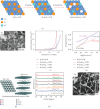Recent Advances in Self-Supported Layered Double Hydroxides for Oxygen Evolution Reaction
- PMID: 32159161
- PMCID: PMC7049786
- DOI: 10.34133/2020/3976278
Recent Advances in Self-Supported Layered Double Hydroxides for Oxygen Evolution Reaction
Abstract
Electrochemical water splitting driven by clean and sustainable energy sources to produce hydrogen is an efficient and environmentally friendly energy conversion technology. Water splitting involves hydrogen evolution reaction (HER) and oxygen evolution reaction (OER), in which OER is the limiting factor and has attracted extensive research interest in the past few years. Conventional noble-metal-based OER electrocatalysts like IrO2 and RuO2 suffer from the limitations of high cost and scarce availability. Developing innovative alternative nonnoble metal electrocatalysts with high catalytic activity and long-term durability to boost the OER process remains a significant challenge. Among all of the candidates for OER catalysis, self-supported layered double hydroxides (LDHs) have emerged as one of the most promising types of electrocatalysts due to their unique layered structures and high electrocatalytic activity. In this review, we summarize the recent progress on self-supported LDHs and highlight their electrochemical catalytic performance. Specifically, synthesis methods, structural and compositional parameters, and influential factors for optimizing OER performance are discussed in detail. Finally, the remaining challenges facing the development of self-supported LDHs are discussed and perspectives on their potential for use in industrial hydrogen production through water splitting are provided to suggest future research directions.
Copyright © 2020 Libo Wu et al.
Conflict of interest statement
The authors declare no conflict of interests.
Figures





References
-
- Gupta U., Rao C. N. R. Hydrogen generation by water splitting using MoS2 and other transition metal dichalcogenides. Nano Energy. 2017;41:49–65. doi: 10.1016/j.nanoen.2017.08.021. - DOI
-
- McKone J. R., Marinescu S. C., Brunschwig B. S., Winkler J. R., Gray H. B. Earth-abundant hydrogen evolution electrocatalysts. Chemical Science. 2014;5(3):865–878. doi: 10.1039/C3SC51711J. - DOI
Publication types
LinkOut - more resources
Full Text Sources
Other Literature Sources
Miscellaneous

